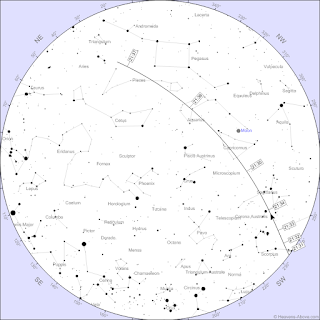 |  |  |
| The ISS pass near the Moon from Adelaide on the evening of Friday 20 November at 20:51 ACDST. Simulated in Stellarium (the ISS will actually be a
bright dot and the size of the Moon is exaggerated), click to embiggen. | The ISS passes near/over the Moon, as seen from Brisbane on the evening of Saturday 21 November
at 19:36 AEST. Simulated in Stellarium (the ISS will actually be a
bright dot and the size of the Moon is exaggerated), click to embiggen. | The ISS near the Moon as seen from Melbourne on the evening of Wednesday November 18
at 21:35 ACEST. Simulated in Stellarium (the ISS will actually be a
bright dot and the size of the Moon is exaggerated), click to embiggen. |
 |  |  |
| All sky chart showing local times from Heavens Above for Friday 20 November from Adelaide, click to embiggen. | All sky chart showing local times from Heavens Above for Saturday 21 November for Brisbane, click to embiggen. | All sky chart showing local times from Heavens Above for Wednesday November 18 from Melbourne, click to embiggen . |
Starting tonight (Tuesday) there are a series of bright evening passes
of the
International Space Station lasting a more or less a week depending on
where you are. For many places in Australia
this series has the ISS being very bright high in the sky, and coming close to the Moon at various times. Almost
everywhere in Australia will see a bright pass tonight anywhere between
7:30 and 10:00 local time.
Similarly, most of Australia sees the ISS pass not far from the Moon
at different days. In Brisbane and sites close to it the ISS may even
pass over the Moon. Example cities are below.
Time Direction Magnitude
| Adelaide 20 Nov ACDST Maximum altitude | 20:55:16 | 66° | 315° (NW) | 453 | -3.1 |
|
|
|
|
|
|
|
|
| Brisbane 21 Nov AEST Maximum altitude | 19:35:45 | 72° | 311° (NW) | 433 | -3.2 |
|
|
|
|
|
|
|
| |
| Melbourne 18 Nov AEDST Maximum altitude | 21:35:51 | 57° | 317° (NW) | 493 | -3.0 |
|
|
|
|
|
|
|
When and what you will see is
VERY location dependent, so you need to use either
Heavens Above or
CalSky
to get site specific predictions for
your location (I'm using
Brisbane, Adelaide and Melbourne as examples, and you can
see how different they are on different days ). Even the difference between the city
centre and the
suburbs can mean the difference between seeing the ISS go very close to
the Moon or over the face of it.
Start looking several minutes before the pass is going to start to get
yourself oriented and your eyes dark adapted. Be patient, on the night
there may be slight differences in the time of the ISS appearing due to
orbit changes not picked up by the predictions. The ISS will be moving
reasonably fast when it passes near the Moon, so be alert to catch the fleeting moment when the pair are close.
Labels: ISS, Satellite, unaided eye
# posted by Ian Musgrave @ 8:21 am











 Click to read about or order
Click to read about or order Click to read about or order
Click to read about or order Click to read about or order
Click to read about or order Click to read about or order
Click to read about or order




